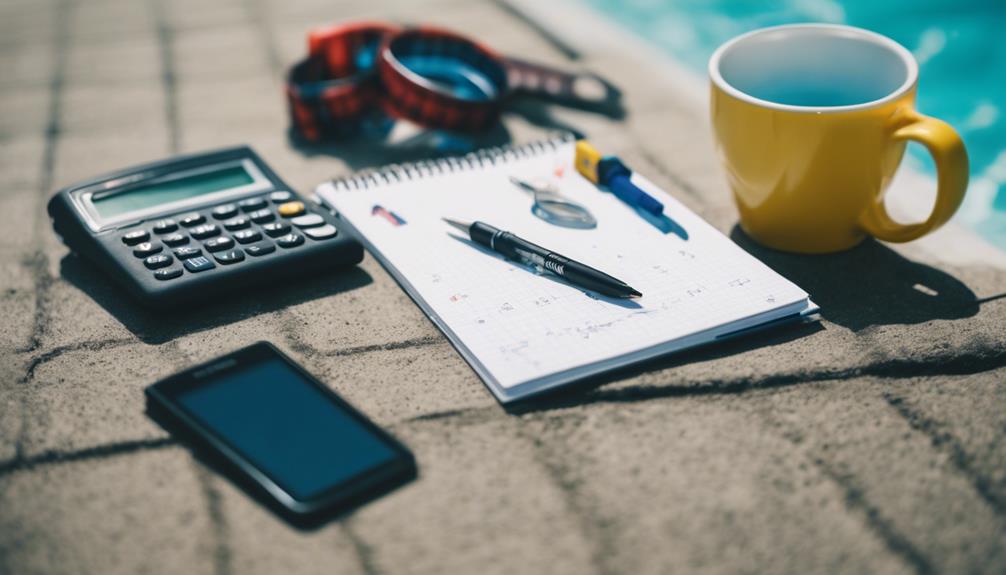In order to accurately calculate the square footage of your swimming pool, start by choosing the pool shape. Get tools such as a tape measure, calculator, pen, and paper. Measure the length and width of the pool precisely. Use the appropriate formula: for rectangular pools, it’s 2lw + 2lh + 2wh; for circular pools, use 2πr² + 2πrh; and for oval pools, use πab + (a + b)√((a – b)² / 4 + h²). Take into account the impact of the pool depth on calculations – deeper pools result in larger areas. Double check your calculation, round it up for accuracy, and finalize the square footage. Additional steps will help improve your knowledge of pool maintenance and chemical treatment planning.
Key Takeaways
- Measure pool shape accurately for precise area calculation.
- Use specific formulas for rectangular, circular, or oval pools.
- Consider pool depth in area calculations for maintenance planning.
- Obtain average depth for volume estimation and chemical dosing.
- Round up final calculated square meters for maintenance efficiency.
Select Pool Shape
To accurately calculate the square meters of your swimming pool, begin by selecting the appropriate pool shape. The depth of the pool is an essential factor in this process.
Different pool shapes, such as rectangular, circular, oval, or irregular, each have their unique formula for area calculation. For instance, rectangular pools require measurements of length and width, circular pools need the radius, oval pools involve major and minor axis lengths, and irregular pools may necessitate breaking down into simpler shapes for precise calculations.
Knowing the pool shape is fundamental in choosing the right formula and ensuring accurate measurement for determining the surface area in square meters. This knowledge enables you to make informed decisions regarding pool maintenance and renovations based on the exact surface area.
Gather Necessary Tools

Selecting the appropriate tools is the first step in accurately measuring your swimming pool's square meters.
Make sure to have a tape measure ready to measure the length and width of the pool.
Additionally, make sure you have a calculator on hand for necessary mathematical calculations.
It's essential to use a pen and paper to jot down measurements and results to avoid any errors.
Clear the pool area of any obstructions such as furniture or toys to get precise measurements.
Double-check your measurements to guarantee precision when calculating the pool's square meters.
Measure Pool Length

Begin by measuring the length of your swimming pool using a measuring tape or ruler, ensuring alignment parallel to the pool edges for accuracy. Measure the distance from one end of the pool to the other, making sure to follow the straight line. This step is vital as the length measurement serves as a fundamental component in calculating the total square meters of your pool accurately. Record this measurement in either feet or meters based on your preferred unit of measurement.
For pools with irregular shapes, consider breaking down the measurements into simpler shapes to facilitate the area calculation process. By obtaining the correct length measurement, you lay the foundation for determining the area equation needed to calculate the square meters of your swimming pool precisely.
Paying attention to detail during this step will lead to a more accurate final calculation of your pool's total area.
Measure Pool Width

To accurately determine the square meters of your swimming pool, start by measuring the width using a measuring tape. Make sure the tape runs across the widest point of the pool, parallel to the edges for precision. Record this measurement carefully as it forms an important part of calculating the pool's total surface area.
Once you have the width, measure the length of the pool in the same manner. Again, ensure the tape is parallel to the pool's sides for accurate results. Write down this measurement as well, as it will be needed for the calculation.
To calculate the square meters of your swimming pool, multiply the width by the length. This simple formula (width x length) will give you the total area of the pool in square meters. Remember to use the same unit of measurement for both the width and length to get an accurate result.
Determine Pool Dimensions
Measure the pool width accurately by using a tape measure and ensuring it runs parallel to the pool edges. When determining the pool dimensions, the width plays an important role in calculating the pool's surface area.
By measuring from one side to the other in a straight line, you obtain the width measurement necessary for accurate area calculations. This measurement should be recorded in feet or meters, depending on the unit used for the calculations.
Ensuring that the tape measure is aligned parallel to the pool edges is essential for obtaining precise results. The width measurement not only aids in calculating the pool's square meters but also influences decisions related to maintenance and operational planning.
Therefore, take care to measure the pool width accurately, as it forms the basis for various essential aspects of managing your swimming pool effectively.
Use Measuring Tape
Utilize a measuring tape to accurately determine the width of your swimming pool. To measure the width, extend the measuring tape across the widest part of the pool. Make sure the tape is straight and parallel to the pool edges for a precise measurement.
This step is important in calculating the surface area of your pool in square meters. Be sure to record the width measurement in either feet or meters based on your preferred unit of measurement.
By following these steps diligently, you can obtain an accurate width measurement, which is essential in the process of calculating the square meters of your swimming pool. Remember that the accuracy of this measurement will directly impact the final calculation of your pool's surface area.
Take your time to measure the width correctly to avoid any inaccuracies in the overall calculations.
Record Width Measurement
When determining the width of your swimming pool, make sure the tape measure runs parallel to the pool edges for accurate measurements.
Remember to follow these essential steps for recording the width measurement effectively:
- Importance is Key: Guarantee the tape measure is aligned parallel to the pool edges to get precise measurements essential for calculating the area of the pool accurately.
- Round Off for Simplicity: Round off the width measurement to the nearest whole number to simplify the subsequent calculations for determining the pool's surface area.
- Unit Consistency: Record the width in either feet or meters, depending on the unit of measurement used for calculating the area of the pool.
Calculate Surface Area

To determine the surface area of a rectangular swimming pool, add up the areas of each side using the formula 2lw + 2lh + 2wh. This formula takes into account the two lengths (l) multiplied by the width (w), two lengths multiplied by the height (h), and two widths multiplied by the height. By calculating these areas and summing them, you obtain the total surface area of the rectangular pool.
This calculation is essential for various pool maintenance aspects like selecting the right pool finish, determining chemical dosing requirements, and sizing equipment appropriately for efficient upkeep. Accurate surface area measurement is key in ensuring the pool functions efficiently and is properly maintained.
Consider Pool Depth

When calculating the square meters of your swimming pool, it's essential to take into account the depth. The depth of your pool directly affects the accuracy of your area calculations.
Depth Impacts Area
Considering the depth of a swimming pool is paramount as it directly influences the total surface area calculation and overall pool maintenance requirements.
When it comes to the depth of your pool, here are three key points to keep in mind:
- The average depth of a pool is essential for accurate volume estimation. Calculated by adding the shallow and deep end depths and dividing by 2, this figure is vital for chemical dosages and maintenance planning.
- Deeper pools not only have a higher volume but also a larger surface area, impacting chemical balance and maintenance needs. Understanding this can help in managing your pool effectively.
- Proper water circulation, heating efficiency, and overall maintenance are all influenced by the depth of your pool. Ensuring you have the correct depth measurements will aid in maintaining a healthy and enjoyable swimming environment.
Measure Accurately for Accuracy
For accurate calculations and maintenance planning, make sure you measure the pool depth precisely using a tape measure from the bottom to the top of the pool wall in feet.
Noting the measurements at the shallowest and deepest points is important if the pool depth varies.
To obtain the average depth accurately, add the depths of the shallow and deep ends, then divide by 2.
Understanding the pool shape and depth is essential for precise surface area calculation and maintenance planning.
Accurate depth measurements are essential for ensuring proper chemical dosing, equipment sizing, and maintenance planning for your swimming pool.
By being meticulous in measuring the depth, you set a solid foundation for effective pool maintenance and care.
Apply the Formula

To calculate the surface area of a swimming pool accurately, apply the appropriate formula based on the pool's shape and dimensions. Different pool shapes require specific formulas for accurate calculation.
For rectangular pools, use the formula 2lw + 2lh + 2wh, where l is the length, w is the width, and h is the height.
Circular pools necessitate the formula 2πr^2 + 2πrh, with r representing the radius and h the height.
Oval pool area can be determined using the formula πab + (a + b)√((a – b)^2 / 4 + h^2), where a and b are the semimajor and semiminor axes.
Check Your Calculation

To guarantee accuracy in your calculations, it's essential to double-check the pool shape and dimensions before applying the corresponding area formula. Make sure that you have accurately measured the length, width, and depth of the pool, including any variations such as slopes or the depth change between the shallow and deep end.
Mistakes in these measurements can greatly impact the final square meter calculation. Specifically, pay close attention to the depth measurements, particularly at the deep end, as inaccuracies here can lead to substantial errors in your final result.
Using a calculator can simplify the process and help you avoid errors, but always verify your result by comparing it to initial measurements or seeking guidance from a professional if needed. Remember, precise calculations are important for proper pool size determination and maintenance planning, so taking the time to double-check your work is crucial for accurate results.
Round Up and Finalize

Guarantee accuracy by rounding up and finalizing your calculated square meters for the swimming pool, taking into account factors like pool finish, chemical treatments, and maintenance needs.
When finalizing the square meters for your swimming pool, consider these essential points:
- Pool Finish: Make sure your calculated square meters accommodate the type of finish you plan to use, such as tiles, plaster, or vinyl, to guarantee a seamless installation process.
- Chemical Treatments: Allocate sufficient surface area to accommodate the distribution and effectiveness of chemical treatments to maintain water quality and hygiene standards.
- Maintenance Needs: Round up the final square meter calculation to allow for proper access around the pool for maintenance tasks like cleaning, repairs, and equipment installation.
Frequently Asked Questions
How to Calculate Square Meters of a Swimming Pool?
To calculate the square meters of a swimming pool, measure its length and width accurately.
For rectangular/square pools, multiply the length by the width.
For circular pools, use the formula A = πr^2 (r = radius).
For irregular shapes, break them down into rectangles/circles.
Accurate calculations are vital for maintenance, chemical dosing, and renovation planning.
Verify precision for effective pool management.
What Is the Formula for the Area of a Swimming Pool?
The formula for calculating the area of a swimming pool varies based on its shape. For rectangular pools, you use 2 times the length times the width plus 2 times the length times the height plus 2 times the width times the height.
Circular pools involve 2 times pi times the radius squared plus 2 times pi times the radius times the height.
Oval pools have a more complex formula involving pi times the major axis times the minor axis and additional calculations.
How to Calculate the Square Footage of a Swimming Pool?
To calculate the square footage of a swimming pool, measure the length and width in feet. For a rectangular pool, use the formula: Area = Length x Width.
If the pool is irregularly shaped, break it down into simpler forms like rectangles or circles to determine the area accurately.
For international standard, convert the square footage to square meters by multiplying by 0.0929.
This calculation aids in planning pool finish, chemical treatments, and heating system requirements.
How Many Square Meters Is a Swimming Pool?
A swimming pool's area in square meters depends on its shape. For a rectangular pool, multiply its length by the width to find the area.
Circular pools involve using πr², with r as the radius, to calculate the area in square meters.
Irregular pool shapes can be simplified to basic shapes for area determination.
Knowing the pool's square meters is essential for maintenance, chemical treatment, and renovation planning.
What Is the Importance of Knowing the Surface Area of a Swimming Pool?
When maintaining a swimming pool, it’s crucial to calculate pool surface area accurately. This measurement helps determine the amount of chemicals needed and the level of maintenance required. Additionally, knowing the surface area is essential for planning renovations and upgrades to ensure proper coverage and optimal performance.
What Are the Benefits of Knowing the Square Meters of Your Swimming Pool?
Knowing the square meters of your swimming pool allows you to accurately calculate pool surface area for maintenance and chemical treatments. With this information, you can also determine the right amount of materials needed for renovations or repairs, making it easier to maintain and enjoy your pool.
Conclusion
To sum up, calculating the square meters of a swimming pool can be easily done by following simple steps. By selecting the pool shape, gathering the necessary tools, measuring the length and width, considering the depth, and applying the formula, you can accurately determine the surface area.
Remember to check your calculation, round up as needed, and finalize your measurements. With these steps, you can confidently calculate the square meters of your swimming pool with precision and ease.










